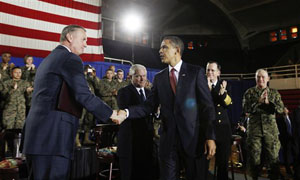|
March 4, 2009 from TheExaminer Website
General Jones & President Obama shaking hands at
On February 13, 2009, President Obama released his first National Security Directive. Titled Presidential Policy Directive -1, it greatly expands the power of the National Security Council (NSC) to oversee all executive departments and agencies.
The Directive introduces new members into top level NSC meetings including the Energy Secretary and the U.S. representative to the United Nations. Most significant is that Obama’s National Security Advisor, General James Jones (ret.), was given direct authority to develop and implement policy throughout the NSC system.
Under previous Presidential administrations, a number of interagency committees were not chaired or controlled by the NSC.
Prior to his current
appointment, General Jones was involved in a secretive Boeing
Corporation effort to declassify antigravity technology for
commercial application. Boeing’s declassification efforts were
denied. Obama’s Directive now gives General Jones a second
opportunity to have antigravity technology declassified for
commercial development.
The Biefeld-Brown Effect is based on the research of Thomas Townsend Brown who in 1928 gained a patent for his practical application of how high voltage electrostatic charges can reduce the weight of objects. The B-2 bomber employs sufficiently high voltages to significantly reduce its weight. This enables the B-2 and other classified antigravity vehicles to display flight characteristics that appear to defy conventional laws of physics.
The idea that advanced antigravity technologies exist and have been developed by the military-corporate entities is supported by the former CEO for Lockheed Skunk works.
Ben Rich said:
While a Presidential Directive is not quite an "act of God", it may
be enough to open the door for the release of antigravity
technology. Especially so given the background of the man given the
responsibility to run the NSC - former Marine Commandant, General
Jim Jones.
In 2002, an internal Boeing project called “Gravity Research for Advanced Space Propulsion” (GRASP) had been disclosed to the aerospace industry. A GRASP briefing document obtained by Jane’s Defense Weekly stated Boeing’s position:
According to a 2008 book by Dr Paul LaViolette, Secrets of Antigravity Technology, Boeing completed a separate classified study for the U.S. military of electrogravitic propulsion recently before October 2007. Boeing was rebuffed in its efforts to have such technology declassified and released into the public sector.
As a Board Director and member of Boeing’s Finance Committee at the time of the 2007 classified study, General Jones was privy to and supported Boeing’s efforts in antigravity research and development. The governmental entity that rebuffed Boeing efforts was very likely an interagency committee that was not under the direct control of the NSC at the time of the Bush administration.
This has been part of a historic trend in which antigravity and other highly advanced technologies have been increasingly placed under the control of corporate entities as trade secrets. The most practical way of reversing this historic trend is to increase the power of the NSC and ensure it has direct oversight over all interagency committees.
This is precisely what Presidential Policy Directive -1 makes
possible.
Jones will then be able to exercise his authority over corporate entities involved in joint research and development projects with government agencies and military departments. This could not come at a better time given the present economic difficulties in the U.S. and the world.
The release of antigravity and other advanced technologies will spur financial investment and development in ways that can greatly stimulate the global economy. This may lead to a significant behind the scenes power struggle between Obama's enhanced NSC and elements of the corporate sector.
Jones appears to be the right person to successfully head Obama's NSC during such a struggle.
The first 100 days of the Obama administration promises much progress towards the commercial release and development of antigravity technologies.
|

